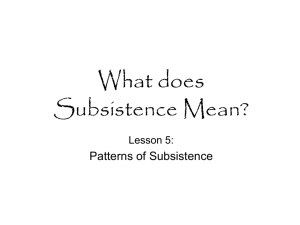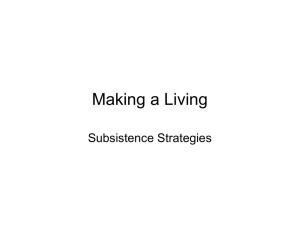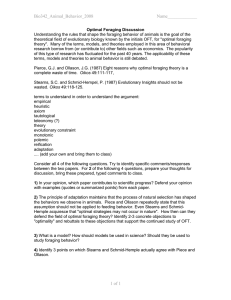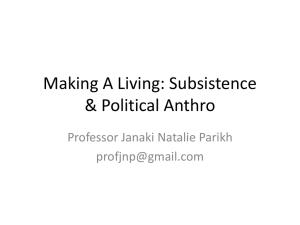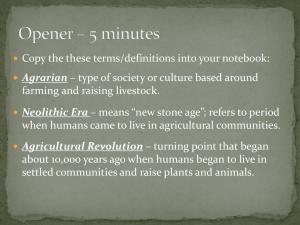Economies and Their Modes of Production
advertisement
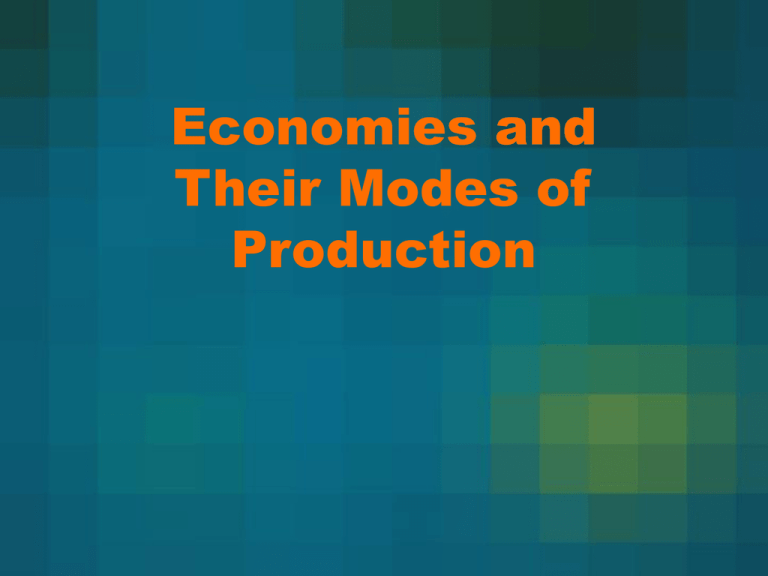
Economies and Their Modes of Production Modes of Production Cross-Culturally • • • Examines society’s way of producing goods, food, and services. Also examines the rules about ownership and control of resources. 2 major elements to examining production: – – Ownership/control rules. Type of technology used. Modes of Production Foraging: aka hunting and gathering Horticulture, aka swidden farming Pastoralism Agriculture: Intensive Industrialism SummaryReasons for Production Foraging Horticulture Production for use Pastoralism Agriculture Industrialism Production for profit Division of Labour Family based Class based Property Relations Egalitarian/collective Stratified/private Resource Use Extensive/temporary Intensive/expanding Sustainability High degree Low degree Foraging, or hunting & gathering • Based on using food provided by nature – gathering, fishing, hunting – emerged at least 300 000 years ago – Major mode of production for 95% of human history. • • • • Maintains balance between resources and lifestyle Often nomadic, as people move to follow food resources. Relies upon large areas of land and spatial mobility. Usually egalitarian, since property cannot be accumulated and stored. Overturning old biases: the myth of hunting scarcity • Until the 1960s, many anthropologists assumed that foragers lived insecure lives, since they had been pushed onto marginal environments. • Lee: overturned 3 major assumptions: – i. that hunting provided the major source of food. – Ii. that ‘hunters’ had to spend the majority of their time securing food. – Iii. That women were not involved in subsistence activities. The Dobe !Kung in the 1960s-1970s • • • • • • • • • • • • Inhabit the semi-arid northwest region of the Kalahari desert in nw Botswana. 14 camps, each linked to a waterhole, consisting of 466 people. Even during a drought year, subsistence was secure. Vegetable foods, esp. mongongo nuts, provide 60-80% of their diet. Women mainly gathered, hence provided the major food inputs for the group. Hunted game animals were less secure, but more highly valued. Average work week was 2.5 days. Children, adolescents and the elderly did not work. 10% of the population were elderly. Caloric and protein intakes were comparable to diets in richer, industrialized countries. Average distance for gathering and/or hunting was 6 miles. Regular rhythms of work and leisure. Men often did not hunt for weeks, but spent their time as ritual specialists, esp. organizing trance dances, a major form of healing. “Man the Hunter” versus “Woman the Gatherer” • • • • Many early anthropologists emphasized the role of males as the dominant provider in foraging groups. However most everyday food is gathered by women (Slocum 1975), i.e. women provide the staple food. – Women are also involved in important band decisions. Both women and men are involved in child-rearing. However, in situations where the !Kung have taken up farming, women become much more confined to the home and to domestic activities. Horticulture, also called swidden or slash and burn agriculture • • • • • • Emerged about 14,000 bp Defined as the cultivation of domesticated crops in gardens using hand tools May also involve domesticated animals. – Domestication: the process by which the reproduction of plants or animals becomes dependent on human intervention. Crop yields can support denser populations than foraging, typically associated with villages of between 500-2,000 people. Constrained by time required for fallowing, swidden cultivation is ecologically sound only when forests are left fallow to regenerate their nutrients. Found in many highland, tropical jungles, e.g. mesoamerica, south america, india and southeast asia, parts of africa. horticulture and social organization • • • • • An extended family forms the core work group. Property in land is held usually by a kinship group, e.g. a lineage or clan. Kinship relations become dominant, unilineal descent groups are common. Technology involves gardening tools, plus domestication, but not draught animals. Work input increases in comparison with foraging; and children work more in horticultural groups than in foraging. Pastoralism • • • Based on the domestication of animal herds and the use of their products Existed in Europe, Africa and Asia Provides over 50% of group’s diet – Pastoralists trade with other groups to secure food and goods they can’t produce – Usually patrilineal. Intensive Agriculture Intensive strategy of production: defined by the use of draught animals for ploughing, and irrigation. – more labour, use of fertilizers, control of water supply, use of animals • Permanent settlements and wealth accumulation. • Produce large surpluses, e.g. rice cultivation can produce 5X the amount needed by a family. • Heavy work input during peak periods of ploughing and harvesting. • Associated with the emergence of individual property in land. • Also linked to the rise of a complex division of labour, with artisans, craftspeople, emerging to service the agricultural economy, paid in kind or in cash by landowners. • Differentiated from industrial farming, in that intensive agriculture does not use mechanized inputs, e.g. tractors. Main Types of Agriculture Peasant Farming Plantations Industrial •1billion people are involved in family farming •Used to grow tea, coffee, rubber •Capital-intensive •Family based •Clear gender roles •Large families •More rigid class distinctions •Land rights can be bought or sold •Concentrated ownership of land •Hired labour •Severe inequality •Dominant in former colonies •Poor social welfare for workers •Uses machines instead of human labour •Used in industrialized countries •Uses more energy •Decline of the family farm Intensive Agriculture - a good move? “Progressive” - Most Euro-Americans think that agriculture is a major advance in cultural evolution. “Revisionist” - agriculture may be “the worst mistake in the history of the human race” Industrialism • • • • • The production of goods through mass employment in business and commercial operations Capital-intensive; can be either privately or state-owned. Complex division of labour, goods are produced for sale. Employment increases in manufacturing and service sectors Formal and informal sections
